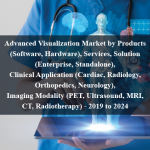OVERVIEW
The X-Ray Detectors Market is currently valued at USD 3.1 billion in 2024 and will be growing at a CAGR of 5% over the forecast period to reach an estimated USD 4.2 billion in revenue in 2029. The X-ray detectors market is witnessing significant growth driven by advancements in medical imaging technologies, burgeoning demand for non-destructive testing across industries, and increasing security concerns globally. With innovations in digital imaging technologies, such as CMOS and CCD sensors, coupled with the integration of artificial intelligence for image enhancement and analysis, X-ray detectors are becoming more efficient, accurate, and versatile. Moreover, the rising adoption of X-ray detectors in healthcare for early disease diagnosis, particularly in regions witnessing demographic shifts and a surge in chronic diseases, further propels market expansion. Additionally, stringent regulatory standards mandating the implementation of X-ray screening systems in airports, transportation hubs, and critical infrastructure facilities are boosting market penetration. The market landscape is characterized by intense competition among key players, driving continuous innovation and product development to cater to diverse application needs across medical, industrial, and security sectors.
First and foremost, technological advancements, especially in digital imaging technologies like CMOS and CCD sensors, are enhancing the performance and capabilities of X-ray detectors, making them more efficient and accurate. Additionally, the increasing demand for non-destructive testing across various industries, including automotive, aerospace, and electronics, is fueling market growth. In the healthcare sector, the rising prevalence of chronic diseases and the need for early and accurate diagnosis are driving the adoption of X-ray detectors. Moreover, stringent regulatory standards mandating the implementation of X-ray screening systems in security-sensitive areas such as airports and transportation hubs are further contributing to market expansion.
Table of Content
Market Dynamics
Drivers:
First and foremost, technological advancements, especially in digital imaging technologies like CMOS and CCD sensors, are enhancing the performance and capabilities of X-ray detectors, making them more efficient and accurate. Additionally, the increasing demand for non-destructive testing across various industries, including automotive, aerospace, and electronics, is fueling market growth. In the healthcare sector, the rising prevalence of chronic diseases and the need for early and accurate diagnosis are driving the adoption of X-ray detectors. Moreover, stringent regulatory standards mandating the implementation of X-ray screening systems in security-sensitive areas such as airports and transportation hubs are further contributing to market expansion.
Key Offerings:
In the dynamic landscape of the X-ray detectors market, key offerings encompass a range of advanced technologies and solutions tailored to meet diverse application needs across medical, industrial, and security sectors. Leading manufacturers provide a comprehensive portfolio of X-ray detectors, including both direct and indirect conversion detectors, offering superior image quality and enhanced sensitivity. These detectors are integrated with state-of-the-art digital imaging technologies such as CMOS and CCD sensors, enabling high-resolution imaging with reduced radiation exposure. Moreover, key players offer customizable solutions equipped with advanced features like real-time image processing, image enhancement, and artificial intelligence algorithms for automated analysis, enhancing diagnostic accuracy and workflow efficiency in medical imaging applications. Additionally, in the industrial sector, X-ray detectors are equipped with ruggedized designs and specialized software for non-destructive testing applications, ensuring precise defect detection and quality assurance in manufacturing processes. Furthermore, in the security domain, X-ray detectors are tailored to meet stringent regulatory standards, offering reliable threat detection capabilities in airports, transportation hubs, and critical infrastructure facilities.
Restraints :
The market for X-ray detectors has considerable growth potential, but there are some obstacles that could prevent it from growing. One significant obstacle is the high cost of sophisticated X-ray detector technology, which could restrict their use, especially in developing nations where the industrial and healthcare sectors have tight budgets. Furthermore, worries about radiation exposure and other health dangers related to X-ray imaging methods continue to arouse public and regulatory scrutiny, which could impede market expansion. Adoption is further hampered by the difficulty of integrating X-ray detectors into current workflows and systems, particularly in industrial and hospital environments. Geopolitical unrest and interruptions in the global semiconductor supply chain may also result in supply chain bottlenecks, which would limit the availability of essential components for the production of X-ray detectors and impede market expansion. In general, industry stakeholders must work together to find cost-effective solutions, address health concerns, expedite integration procedures, and guarantee supply chain resilience in order to address these issues
Regional Information:
• In North America, particularly in the United States and Canada, the X-ray detectors market is flourishing. The region boasts advanced healthcare infrastructure and a strong focus on technological innovation, driving the demand for high-performance X-ray imaging solutions. Additionally, stringent regulatory standards and a robust research ecosystem contribute to the market’s growth, with a particular emphasis on medical imaging applications.
• Europe, including key markets such as Germany, France, and the United Kingdom, exhibits significant growth in the X-ray detectors market. This growth is fueled by increasing healthcare expenditure, a growing geriatric population, and a rising incidence of chronic diseases necessitating advanced diagnostic tools. Furthermore, stringent regulatory frameworks and a strong emphasis on quality assurance drive the adoption of X-ray detectors across various sectors, including healthcare, industrial, and security.
• The Asia Pacific region, encompassing major economies such as Japan, China, and India, presents immense opportunities for the X-ray detectors market. Rapid urbanization, increasing healthcare investments, and a burgeoning industrial sector contribute to the region’s growth. Moreover, rising awareness about the benefits of non-destructive testing in industries such as automotive, aerospace, and electronics further fuels market expansion. Additionally, the adoption of digital healthcare technologies and government initiatives to enhance healthcare infrastructure drive the demand for X-ray detectors in medical imaging applications.
• Latin America and the Middle East & Africa regions are witnessing steady growth in the X-ray detectors market, albeit at a comparatively slower pace. Improvements in healthcare infrastructure, increasing investments in security solutions, and a growing focus on industrial development contribute to market growth in these regions. However, economic challenges and regulatory constraints pose some barriers to market expansion, which are being gradually addressed through strategic partnerships and technological advancements.
Recent Developments:
• In May 2023, Varex Imaging Corporation launched the XRD 3131N digital X-ray detector to cater to the rising demand for expedited and more extensive inspections within the rapidly evolving Electric Vehicle (EV) battery manufacturing sector. This enhances the company’s existing portfolio for the EV battery inspection market.
• In July 2022, Canon Inc. launched the CXDI-Elite series of wireless digital radiography (DR2) devices, including the CXDI-720C Wireless sensor unit, to markets outside of Japan. These devices aim to enhance user-friendliness across various imaging scenarios while delivering superior image quality to facilitate more accurate diagnostics.
Key Players:
Thales Group, Teledyne DALSA, Canon, Konica Minolta, Fujifilm Holdings Corporation, Carestream Health, PerkinElmer, Hamamatsu Photonics K.K., Rigaku Corporation, and Vararian Medical Systems.
– The X-Ray Detectors Market is expected to reach an estimated value of USD 4.2 billion in revenue by 2029.
2) What is the estimated CAGR of the X-Ray Detectors Market over the 2024 to 2029 forecast period?
– The CAGR is estimated to be 5% for the X-Ray Detectors Market over the 2024 to 2029.
3) Who are the key players in the X-Ray Detectors Market ?
– Thales Group, Teledyne DALSA, Canon, Konica Minolta, Fujifilm Holdings Corporation, Carestream Health, PerkinElmer, Hamamatsu Photonics K.K., Rigaku Corporation, and Vararian Medical Systems.
4) What are the drivers for the X-Ray Detectors Market ?
– Technological advancements in digital imaging technologies are improving X-ray detector performance. The demand for non-destructive testing in industries like automotive, aerospace, and electronics, as well as the need for early diagnosis in healthcare, and stringent regulatory standards, are driving market growth.
5) What are the restraints and challenges in the X-Ray Detectors Market ?
– The X-ray detectors market faces challenges such as high costs, regulatory scrutiny, health risks, integration complexity, and global supply chain disruptions. These factors may limit adoption in emerging economies and healthcare sectors. Collaboration among industry stakeholders is needed to develop cost-effective solutions, mitigate health concerns, streamline integration processes, and ensure supply chain resilience to overcome these obstacles.
6) What are the key applications and offerings of the X-Ray Detectors Market ?
– The X-ray detectors market offers advanced technologies and solutions for medical, industrial, and security sectors. Key manufacturers offer direct and indirect conversion detectors, digital imaging technologies, real-time image processing, and artificial intelligence algorithms. Industrial detectors have ruggedized designs and specialized software for non-destructive testing. Security detectors meet regulatory standards for reliable threat detection in airports and critical infrastructure facilities.
7) Which region is expected to drive the market for the forecast period?
– North America is expected to have the highest market growth from 2024 to 2029
Why Choose Us?
Insights into Market Trends: Global Market Studies reports provide valuable insights into market trends, including market size, segmentation, growth drivers, and market dynamics. This information helps clients make strategic decisions, such as product development, market positioning, and marketing strategies.
Competitor Analysis: Our reports provide detailed information about competitors, including their market share, product offerings, pricing, and competitive strategies. This data can be used to inform competitive strategies and to identify opportunities for growth and expansion.
Industry Forecasts: Our reports provide industry forecasts, which will inform your business strategies, such as investment decisions, production planning, and workforce planning. These forecasts can help you to prepare for future trends and to take advantage of growth opportunities.
Access to Industry Experts: Our solutions include contributions from industry experts, including analysts, consultants, and subject matter experts. This access to expert insights can be valuable for you to understand the market.
Time and Cost Savings: Our team at Global Market Studies can save you time and reduce the cost of conducting market research by providing comprehensive and up-to-date information in a single report, avoiding the need for additional market research efforts.












